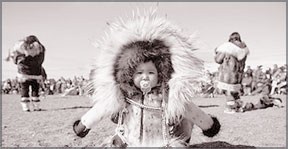Man-made chemicals behind excess of baby girls in Arctic
by Paul Brown in Nuuk, Greenland
Twice as many girls as boys are being born in some Arctic villages
because of high levels of man-made chemicals in the blood of pregnant
women, according to scientists from the Arctic Monitoring and Assessment
Programme (Amap).
The scientists, who say the findings could explain the recent excess
of girl babies across much of the northern hemisphere, are widening
their investigation across the most acutely affected communities in
Russia, Greenland and Canada to try to discover the size of the
imbalance in Inuit communities of the far north.
|

An Inuit child in a traditional parka. |
In the communities of Greenland and eastern Russia monitored so far,
the ratio was found to be two girls to one boy. In one village in
Greenland only girls have been born.
The scientists measured the man-made chemicals in women's blood that
mimic human hormones and concluded that they were capable of triggering
changes in the sex of unborn children in the first three weeks of
gestation. The chemicals are carried in the mother's bloodstream through
the placenta to the foetus, switching hormones to create girl children.
Lars-Otto Reierson, executive secretary for Amap, said: "We knew that
the levels of man-made chemicals were accumulating in the food chain,
and that seals, whales and particularly polar bears were getting a dose
a million times higher than that existing in plankton, and that this
could be toxic to humans who ate these higher animals. What was shocking
was that they were also able to change the sex of children before
birth."
The sex balance of the human race - historically a slight excess of
boys over girls - has recently begun to change.
A paper published in the US National Institute of Environmental
Health Sciences earlier this year said that in Japan and the US there
were 250,000 boys fewer than would have been expected had the sex ratio
existing in 1970 remained unchanged. The paper was unable to pin down a
cause for the new excess of girls over boys.
The Arctic scientists have discovered that many of the babies born in
Russia are premature and the boys are far smaller than girls. Possible
links between the pollutants and high infant mortality in the first year
of life is also being investigated.
Scientists believe a number of man-made chemicals used in electrical
equipment from generators, televisions and computers that mimic human
hormones are implicated. They are carried by winds and rivers to the
Arctic where they accumulate in the food chain and in the bloodstreams
of the largely meat- and fish-eating Inuit communities.
The first results of the survey were disclosed at a symposium of
religious, scientific and environmental leaders in Greenland's capital,
Nuuk, yesterday, organised by the Patriarch of the Orthodox Church,
Bartholomew I, which is looking at the effects of environmental
pollution on the Arctic.
Dr Reierson said the accumulation of DDT, PCBs, flame-retardants and
other endocrine disrupters has been known for some time and young women
had been advised to avoid eating some Arctic animals to avoid excess
contamination and possible damage to their unborn children.
Dr Reierson, said blood samples from pregnant women were subsequently
matched with the sex of their baby. Women with elevated levels of PCBs
in their blood above two to four micrograms per litre and upwards were
checked in three northern peninsula's in Russia's far east - the Kola,
Taimyr and Chukotka - plus the Pechora River Basin.
To check the results the survey was widened and further communities,
including those on Commodore Island, were investigated. The results were
now in for 480 families and the ratio remained the same.
He said full results for the widening of the survey would not be
published until next year but preliminary results for Greenland showed
the same 2:1 ratio in the north.
Aqqaluk Lynge, the former chairman of the Inuit Circumpolar
Conference who hails from Greenland, said: "This is a disaster,
especially for some 1,500 people who make up the Inuit nations in the
far north east of Russia.
"Here in the north of Greenland, in the villages near the Thule
American base, only girl babies are being born to Inuit families.
"The problem is acute in the north and east of Greenland where people
still have the traditional diet.
"This has become a critical question of people's survival but few
governments want to talk about the problem of hormone mimickers because
it means thinking about the chemicals you use.
"I think they need to be tested much more stringently before they are
allowed on the market."
Backstory
The Inuit are nomadic in nature, having survived for thousands of
years using formidable hunting skills to seek out the bowhead whale,
seal, caribou and walrus. The Inuit Circumpolar Conference (ICC), an
international body, was founded in 1977 to represent the rights of the
approximately 150,000 Inuit of Alaska, Canada, Greenland, and Chukotka
(Russia).
With relatively low levels of educational attainment and few
opportunities, violence, alcohol and drug dependency are a growing
problem as the Inuit try to safeguard its traditions.
The Guardian ,UK |
